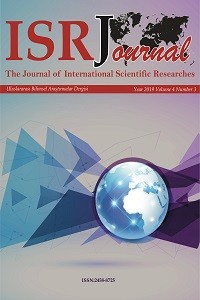Öz
Kaynakça
- Garg, A., Grande, D., Macias-Lizaso Miranda, G., Sporleder, C., Windhagen, E. (2017). Analytics in banking: Time to realize the value [online]. McKinsey&Company, Financial Services. Available at: https://www.mckinsey.com/industries/financial-services/our-insights/analytics-in-banking-time-to-realize-the-value
- Fornell, C. (1992). A National customer satisfaction barometer: the Swedish experience. Journal of Marketing, 56, p.6-21.
- Omidia, A., Khoshtinata, B. (2016). Factors affecting the implementation of business process reengineering: taking into account the moderating role of organizational culture (Case Study: Iran Air). Procedia Economics and Finance, 36, p. 425 – 432
- Lipaj, D., Davidaviciene, V. (2013). Influence of Information Systems on Business Performance. Science – Future of Lithuania, 5(1), p. 38–45Hammer, M., Champy, J. (1993) Reengineering the Corporation: A Manifesto for Business Revolution, Harper Business, New York, NY.Business Process Reengineering Assessment Guide. Version 3 (1997) [online]. Available at: https://govinfo.library.unt.edu/npr/library/gao/bprag.pdf
- Weicher, M., Chu, W. W., Lin, W. C., Le, V., and Yu, D. (1995). Business Process Reengineering Analysis and Recommendations [online]. Baruch College, City University of New York. Available at: https://www.researchgate.net/publication/228605403_Business_process_reengineering_analysis_and_recommendations
- Fitzgerald, G., Siddiqui, F. (2002). Business Process Reengineering and Flexibility: A Case for Unification. The International Journal of Flexible Manufacturing Systems, 14, p. 73–86, 2002
- Factum Group. Internet in Ukraine (2017) [online]. Available at: http://factum-ua.com/
- Jeston, J., & Nelis, J. (2006). Business process management. Oxford: Butterworth-Heinemann.
- Dallas, I., Wynn, M. (2014) Business Process Management in Small Business: A Case Study [online] NICTA Queensland Research Lab, Queensland University of Technology, Brisbane, QLD, Australia. Available at: https://www.springer.com/cda/content/document/cda_downloaddocument/9783642382437-c2.pdf?SGWID=0-0-45-1434386-p175153447
- Chen, J. (2008). Productivity Methodologies, Tools and Techniques: Business Process Re-engineering [online]. Asian Productivity Organization. Available at: http://www.apo-tokyo.org/publications/wp-content/uploads/sites/5/2010_May_p4.pdf
- Choudrie, J., Hlupic, V., Irani, Z. (2002).Teams and their Motivation for Business Process Reengineering: A Research Note. International Journal of Flexible Manufacturing Systems. Volume 14, Issue 1, p. 99-107
- Gantt, H.L. (1910). "Work, Wages and Profit". Engineering Magazine. New York.; republished as Work, Wages and Profits. Easton, Pennsylvania: Hive Publishing Company. 1974.
Business Process' Reengineering of The Servicing Clients of A Commercial Bank by Automating Cash Transactions
Öz
The modern banking sector shows growing competition. In order to stay
afloat, it is necessary to use new methods that increase the level of customer
centricity and help to retain old customers and attract new ones.
In the presented paper, the problem of qualitative and fast customer
service of the commercial bank UKRSIBBANK, which can be achieved through
optimization of business processes of servicing customers (private
individuals), is considered. The main tool is the Business Process
Reengineering method, which involves the automation of cash operations, namely:
providing banking services with the help of cash terminals. The essence of the
improvement is to carry out transactions using special cash terminals, which
can replace the cashier and bank teller positions in a bank.
As a result of the business processes reengineering,
the main tasks set at the beginning of the paper were solved. Those were cuts
in staff involved in cash management business processes and a reduction in
customers’ time for performing simple cash operations, which have been shown
using specific business processes in the presented paper.
In addition, BPR influenced the following criteria:transactions between
clients' accounts, transactions between different banks' accounts, the level of
quality of financial monitoring, quantity of paper documents that confirm
transactions, quantity of cash operations that are done by cashiers, the level
of control of business-processes, time of cash operations, the level of staff
turnover, a reduction of quantity of cashier staff, the level of client
orientation, the level of time waiting in lines, quality of clients' service,
quantity of clients that are satisfied with service, quantity of clients that
are ready to recommend the bank to others.
Moreover, the impact of reengineering on the organizational structure and
document circulation of the bank is considered in the work.
Anahtar Kelimeler
Kaynakça
- Garg, A., Grande, D., Macias-Lizaso Miranda, G., Sporleder, C., Windhagen, E. (2017). Analytics in banking: Time to realize the value [online]. McKinsey&Company, Financial Services. Available at: https://www.mckinsey.com/industries/financial-services/our-insights/analytics-in-banking-time-to-realize-the-value
- Fornell, C. (1992). A National customer satisfaction barometer: the Swedish experience. Journal of Marketing, 56, p.6-21.
- Omidia, A., Khoshtinata, B. (2016). Factors affecting the implementation of business process reengineering: taking into account the moderating role of organizational culture (Case Study: Iran Air). Procedia Economics and Finance, 36, p. 425 – 432
- Lipaj, D., Davidaviciene, V. (2013). Influence of Information Systems on Business Performance. Science – Future of Lithuania, 5(1), p. 38–45Hammer, M., Champy, J. (1993) Reengineering the Corporation: A Manifesto for Business Revolution, Harper Business, New York, NY.Business Process Reengineering Assessment Guide. Version 3 (1997) [online]. Available at: https://govinfo.library.unt.edu/npr/library/gao/bprag.pdf
- Weicher, M., Chu, W. W., Lin, W. C., Le, V., and Yu, D. (1995). Business Process Reengineering Analysis and Recommendations [online]. Baruch College, City University of New York. Available at: https://www.researchgate.net/publication/228605403_Business_process_reengineering_analysis_and_recommendations
- Fitzgerald, G., Siddiqui, F. (2002). Business Process Reengineering and Flexibility: A Case for Unification. The International Journal of Flexible Manufacturing Systems, 14, p. 73–86, 2002
- Factum Group. Internet in Ukraine (2017) [online]. Available at: http://factum-ua.com/
- Jeston, J., & Nelis, J. (2006). Business process management. Oxford: Butterworth-Heinemann.
- Dallas, I., Wynn, M. (2014) Business Process Management in Small Business: A Case Study [online] NICTA Queensland Research Lab, Queensland University of Technology, Brisbane, QLD, Australia. Available at: https://www.springer.com/cda/content/document/cda_downloaddocument/9783642382437-c2.pdf?SGWID=0-0-45-1434386-p175153447
- Chen, J. (2008). Productivity Methodologies, Tools and Techniques: Business Process Re-engineering [online]. Asian Productivity Organization. Available at: http://www.apo-tokyo.org/publications/wp-content/uploads/sites/5/2010_May_p4.pdf
- Choudrie, J., Hlupic, V., Irani, Z. (2002).Teams and their Motivation for Business Process Reengineering: A Research Note. International Journal of Flexible Manufacturing Systems. Volume 14, Issue 1, p. 99-107
- Gantt, H.L. (1910). "Work, Wages and Profit". Engineering Magazine. New York.; republished as Work, Wages and Profits. Easton, Pennsylvania: Hive Publishing Company. 1974.
Ayrıntılar
| Birincil Dil | İngilizce |
|---|---|
| Bölüm | Makaleler |
| Yazarlar | |
| Yayımlanma Tarihi | 22 Ekim 2019 |
| Gönderilme Tarihi | 22 Mart 2019 |
| Yayımlandığı Sayı | Yıl 2019 Cilt: 4 Sayı: 3 |

Bu eser Creative Commons Atıf-GayriTicari 4.0 Uluslararası Lisansı ile lisanslanmıştır.


